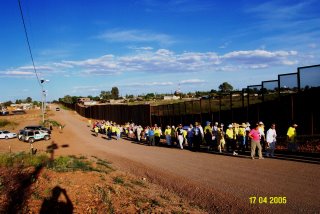 (picture courtesy of www.cpt.org)
(picture courtesy of www.cpt.org)Boundaries; Where are the Boundaries? It’s seams as if boundaries are all the talk of the media these days. Actually, one cannot speak of human life without speaking of boundaries. Even the Postmodern thinker must finally affirm that there are at least physical boundaries to human life and that those physical boundaries must necessarily effect how society views metaphysical boundaries. People like Jacques Derrida and Michel Foucault would speak of boundaries in terms of subjectively formed communities. They would suggest that what is important is that communities leave the boundaries open enough to allow new ideas to filter through and change the boundaries and the very nature of the community.
Nevertheless, we are not here to discuss how postmoderns view boundaries but how boundaries should be viewed in relation to the interrelational character of the Body of Christ. Brian McLaren takes a stab at boundaries for the Church in his latest book, The Secret Message of Jesus. Brian tries to define his idea of what the “Borders” of the church should be; “The kingdom of God, then, seeks a third way: not exclusiveness and rejection on the one hand, and not foolish, self-sabotaging inclusion of the other hand, but rather purposeful inclusion.” (pg. 167) This idea of “purposeful inclusion” is the central point of Brian’s ecclesiology. I will not break his whole argument down here but he certainly points out some relevant Biblical principles, while also overlooking some as well. Is Brian’s terminology of “purposeful inclusion” sufficient to faithfully explain the Biblical boundaries of the Body of Christ? Do we speak of two different things when we speak of inclusion in the Body of Christ and inclusion in the local church?
I would like to suggest that, at least when speaking of inclusion within the Body of Christ, the terminology of “conditional inclusion” is more faithful to Divine revelation than Brian’s “purposeful inclusion.” Purposeful inclusion sounds as if we are the ones controlling the inclusion rather than God. I think it is the Body’s obligation to image Christ in such a way that the boundaries and the gates are plainly portrayed to a watching world, a world desperately in need of discerning that they are on the wrong side of the Boundary and in need of seeing that there is but one Way through.
Where do you see the boundaries lying? Are we the gate keepers of a “purposeful inclusion” or are we ambassadors with a message of “conditional inclusion”?